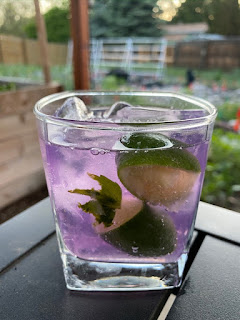Urban farming, travel, growing enough food to last year round. Whatever you think this is... it's probably not that...
Sunday, December 13, 2020
Order Those Seeds!!!
Saturday, December 5, 2020
Composting: Turn Your Food Scraps into Nutritious Black Gold
“The ground's generosity takes in our compost and grows beauty! Try to be more like the ground.” - Rumi
 |
| Fresh Compost Added to Garlic Patch |
Composting is key to a healthy garden, there are absolutely no if's, and's, or but's about it. If you want a healthy garden, you need to be composting, that is a plain and simple fact. Composting is the simple act of taking food scraps, letting it break down and be turned back into highly nutritious soil, which you then add to your existing ground. This allows you to give back to the ground so you are not always taking from it. I always like to compare this to a bank account, if you do nothing but withdraw from your bank account and you're not contributing to it at all, well one day this bank account will be empty and you will have nothing, absolutely nothing. If you are growing anything in your soil, you need to be giving back to it so the ground will continue to give to you in the future. Otherwise you'll be left with a barren wasteland that has given all it has to give and is basically dead due to your greedy ignorance. So lets avoid this, shall we?!
Saturday, November 21, 2020
Gardens and Art Intertwined: From Orchids to Monet
- Maya Angelou
 |
| Orchids at the Denver Botanic Gardens |
Saturday, November 14, 2020
Tilling & Broadforking - Break that Dirt Up!
“The journey of a thousand miles begins with one step.” – Lao Tzu
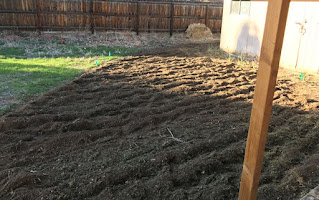 |
| Freshly tilled and broadforked yard! |
To till or not to till? That is the question.
Some like to till, some like to broadfork, some like to do both, and some like to do none of the above. I'm going to take a wild guess and say that you likely don't have the slightest idea what that means. That is perfectly okay and expected, don't even worry about it! These are just ways of breaking up the ground so the dirt isn't so compact which gives the future plants room to grow. For now we're going to stay away from the debate of to disturb the ground or not to disturb the ground (it really is the question though). If you are just starting out and converting a lawn (or very compact ground) into vegetables then tilling is inevitable. There really aren't any ifs ands or buts about it, regardless of the debates around it. Tilling is going to take the existing grass, turn it back into the soil, while also mixing up and aerating the dirt. Then when you go over the same area with the broadfork, you are breaking up this soil even further giving roots of plants more room to grow. Say you're going to move into a house but when you open the front door the house is jam packed with useless stuff and you can't move in. Going nuts, clearing and cleaning that house is the same thing as tilling and broadforking. Once you're done there's room to move-in and be comfortable. It's out with the old and in with the new. Tilling and broadforking is basically the first step in restarting and rejuvenating your yard, you're pressing the reset button and starting from scratch. Once you have your vegetable garden established though do you really need to keep tilling and broadforking the soil? THAT is exactly where the debate generally starts up and can turn into quite a heated conversation, depending on who you're talking to.
Wednesday, October 28, 2020
September of 2020 Update
September, pretty much the exact same as August, just more food that keeps growing and cooler weather. The urban farm continues to challenge my ability to harvest produce at its peak then either eat it, preserve it, or give it away before it goes bad. I'm getting pretty dang good at that game (and it is a game) but alas there's still a small amount of food that goes bad such as the cucumbers that I couldn't give away to save my life (it's a long story for another time). The largest single day harvest happened, which was a whopping 205.8 pounds (93.35 kilos) of fresh, beyond organic, hyper local food grown right in my very own backyard. That was right before a snow storm rolled in so I harvested everything I could find. That storm did bring snow however the majority of the plants survived and I kept getting food after that storm. It seemed that since it was so warm before the snow, the ground was able to keep roots warm and emit heat to keep the bases of the plants warm with the weather that just dipped below freezing while spitting snow everywhere. More composting happened in September, I've really been trying to stay on-top of composting as much as possible. There's been a lot of black gold (compost) produced this year. Here's what was harvested in September:
Sunday, October 11, 2020
Plant that Garlic!
-Anthony Bourdain
 |
| My seed garlic for the 2021 year that I grew in 2020 |
Now that your urban farm / garden is planned out and your utilities are marked, we need to get rocking by ordering and planting garlic!!
Right now (October) is the time to be planting your garlic for the 2021 season. The 2020 season just finished (actually still ongoing for me at the moment), it's not even winter yet, but we need to get the garlic in the ground ASAP! Garlic loves the cooler weather, needs it to grow properly, and is extremely hardy. Garlic also just so happens to be the easiest thing to grow! Garlic can be planted in the very early spring if you don't want to plant it just yet. If your ground is currently grass then it's certainly preferable for it to be tilled / broadforked before planting the garlic. Right now, time is of the essence and we don't have time for that at the moment. If you're feeling adventurous though just plant it right in with the grass, it'll grow, but you can't mow the surrounding grass once it starts growing. You can also wait to plant the garlic until after you've tilled / broadforked or until the early spring, but it's preferable to plant that garlic before winter!
Saturday, October 10, 2020
Plan Your Urban Farm / Garden
— Wendell Berry
Here we go people, it's time to get a rough plan together for your Urban Farm / Garden!
Before anything can be done (the garlic does need to be planted ASAP) you need to have a rough idea of where you are going to plant everything. We just need this to be a very rough idea of where you want to plant / not plant and in which direction the rows are going to go, etc. At this point you do not need to know exactly what you're going to plant, we can figure that out later. Just knowing where everything is going to go is key at the moment.
The easiest way to do this is to draw your yard on a piece of paper and mark which areas you want to plant / not plant in, like this:
 |
| Map of where to grow food! |
Monday, October 5, 2020
How to Urban Farm
"Hey Urban Farmer Guy, this is all cool and everything but how in the world can I do this myself??? Where do I even start? What do I do? How do I Urban Farm?"
That is a fantastic question and it is exactly what I'm going to delve into next on this blog. Now that you've had a chance to follow me for a season and you have a better idea of what I do. I'm going to show you how YOU can do this too! The time to start planning for the 2021 gardening season is NOW! You can't delay it at all and you certainly can't put it off until the spring, that is wwwwaaaaayyyyyy too late to start thinking about it (although it is precisely what I did in my first season). The planning needs to commence and the building blocks need to start right NOW. It's actually already time to plant the garlic so we are even a bit late to the game and behind for the 2021 season but fear not!!! It'll be okay, we'll get there!
 |
| You can do this too (yes you)! |
Monday, September 28, 2020
August of 2020 Update
 |
| One of the many bountiful harvests of August 2020 |
Tuesday, September 22, 2020
July of 2020 Update
 |
| Aerial View of the Urban Farm |
It's about time I get around to writing the update for July of 2020! It's amazing how quickly time flies when there's an endless to-do list for the urban farm. July is really when the fruits of my labor start showing, I spend so much time picking and preserving food along with trying to keep up with composting and just the general hustle and bustle of all of the plants growing. There's a noticeable difference in the growth of the plants from morning to evening as well as from when I go to bed and wake up. The veggies never stop growing, which means I can't stop tending to them. Between harvests, my time is spent figuring out what I'm going to eat soon and what I need to preserve for the winter and how I'm going to preserve it. I'm really starting to get this dialed in but it comes down to if something doesn't keep well in the fridge, I either eat it right away or preserve it for the winter. Minimizing waste is one of my main focal points this year.
Saturday, August 22, 2020
Equality: How is This Even a Debate?
 |
| Incense Burning Individually Yet Together (Malaysia - 2007) |
Saturday, August 8, 2020
June of 2020 Update
Saturday, July 11, 2020
The Urban Farmers Gin & Tonic
Sunday, June 28, 2020
May of 2020 Update (Even Though it's Almost July)
Saturday, June 20, 2020
Tear Down Your Learning Barriers!
Saturday, May 30, 2020
April of 2020 Summary
 |
| Triumph Tulip |
Monday, May 25, 2020
Summertime is Margarita Time!
 |
| Enjoying a Homemade Margarita on the Patio |
Saturday, May 16, 2020
Seeds, Where it all Begins!
Saturday, May 9, 2020
Hopes, Dreams, and Goals for 2020
- Thomas Jefferson
Who knows what the fourth year of the urban farm will bring. My overall goal is fairly simple:
Try and get the farm to be as productive, if not more productive, than last year while simultaneously expanding my general, overall, knowledge and doing a better job of preserving food for the winter along with focusing more on composting and soil health.
That should be a fairly easy and attainable goal however the reality is that each year you have no idea what challenges mother nature is going to throw at you. Hail from a storm could annihilate the urban farm within a five minute time span. There could be a late frost after transplanting the seedlings (last year there was snow in the last week of May). Pests that I haven't encountered before could decide that they love my urban farm and want to reside here. There are so many unknowns but you just have to trust what you already know to get you through whatever challenges you may encounter during the growing season.
Saturday, May 2, 2020
Top Ten Things I've Learned (So Far)
1. Weeds suck. Landscaping fabric helps a lot to keep the weeds manageable. Some weeds even emit chemicals from their roots to kill off surrounding plants to help the weed thrive. Pull them as soon as possible.
Saturday, April 25, 2020
It's Not All Unicorns and Rainbows
As you look at the mass amounts of photos in the recaps of the last three years it's easy to look at those and say, "Man, this James the urban farmer guy has this whole thing figured out, look at him go!" While I know more than I did when I started doing this, the reality is I still know very little compared to a lot of other people who farm for a living. There's so much to know and a lot of it can be very specific to the area that you live in. One of these days when I feel like my farming knowledge is more up to snuff it would be really fun to travel to a different part of the country (or a different country completely) and try and do the same thing just to see if I can do it and if it's just like starting from square zero again. Behind those great looking photos that you saw in my previous posts is a lot of hard work along with quite a lot of blood, sweat, and tears. It's way too easy to only focus on the positive aspects of the urban farm and to spin it as a complete walk in the park. I'm trying fairly hard to put a realistic view on everything that goes into trying to gain independence from the major food system that's in place in the U.S. As I was putting together those previous posts I realized one major thing was lacking in my photos and also from the recaps: failures. Each year there are so many things that go wrong and I generally don't want to remember them but for the purposes of this blog I do want to put extra effort into trying to highlight those as best as I can just to show everyone who may somehow stumble across this blog that it takes a lot more than just throwing seeds in the ground (although that has worked for me in the past). Going forward I'll be making an extra effort to take photos of things that fail or go horribly wrong (this makes me cringe just thinking about it). You also probably noticed some out of place photos in those recaps, such as the San Francisco and Panama photos. You would most certainly be correct in calling me out and telling me that those photos don't have a place in this urban farming blog. If that is what you're thinking though the thing you're failing to realize and the reason that statement is completely and utterly wrong is that this is James the urban farmer's blog and I'm just going to go ahead and put whatever I want in here and write about whatever the hell I feel like. If you don't like that then go ahead and find yourself a different blog to entertain yourself, the world will keep on spinning and I'll keep on writing. As a result, there are probably going to be some posts and photos that seem out of place from time to time. Deal with it (or don't, I don't care).
Saturday, April 18, 2020
Third Full Season Recap (2019) - Part III
Thursday, April 16, 2020
March - Pandemic 2020: When the World Started to Almost End (Again)
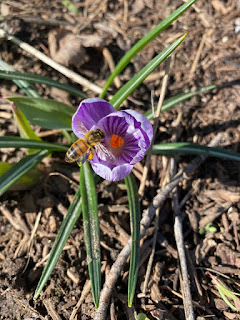 |
| Honey bee going to gather pollen from a purple crocus in the wildflower yard! |
March of 2020 was really just when the U.S. started catching up to the rest of the world with the Coronavirus Pandemic and in true American fashion we took it upon ourselves to show the rest of the world up and be #1 with this pandemic by having more cases than any other country. America is always trying to be #1, except for things that really matter such as education and healthcare. We went from seeing Coronavirus as being a far off threat, to watching it slowly creep across the globe, to it hammering normal lives everywhere and bringing the economy to a screeching halt. By the end of March schools were closed, unemployment skyrocketed to record high levels seemingly overnight, small business owners are left wondering how they're going to keep their businesses afloat, non-essential businesses were ordered to close, states were starting to impose "Stay at Home Orders", meaning you are not to leave home aside from "essential" services or needs, sports were cancelled, churches closed, grocery store shelves were empty, you felt like you won the powerball if you were able to snag any toilet paper or cleaning supplies, hospitals were starting to fill up, shortages of masks and gowns, doctors and nurses were and still are working around the clock and don't have the supplies they need to treat people, morgues are running out of space, panic buying ensues, roads were more or less empty, Tiger King was the talk of the town. Basically people were freaking out and not sure how to respond to something like this. It's way too easy to focus on all the negative aspects of what has happened and what is continuing to happen in the world currently, but it's more important than ever to point out all of the good that is happening.
Saturday, April 11, 2020
Third Full Season Recap (2019) - Part II
– Minnie Aumonier
Everything's looking pretty good (July 2019):
Saturday, April 4, 2020
Third Full Season Recap (2019) - Part I
Saturday, March 28, 2020
Second Full Season (2018) Recap
Saturday, March 21, 2020
First Full Season (2017) Recap
Wednesday, March 18, 2020
February of 2020 Overview
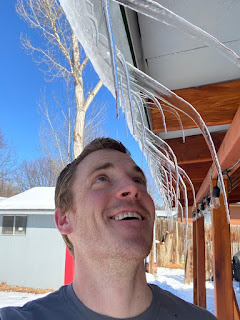 |
| Crazy Ass Icicles |
The month of February are when things start ramping up for the urban farm. I usually try and start the first seedlings of the year during the first few weeks of February depending on what else I have going on in my life. The peppers need to get started first since they take the longest to grow but as a result of laziness combined with striving to be as efficient as possible this year I started as many seedlings as I could along with the peppers. I definitely try and limit it to the things that take a while to grow (peppers take ffffooorrrrreevvvveeeerrrr to grow) since my laundry room only has so much space for seedlings. In years past I've started seeds in the small 1x1 seed blocks that you commonly see at garden stores. I've grown to dislike using these as you have to transplant the seedlings to a bigger pot fairly fast or else the plant growth gets stunted and that seems to happen anyways when you transplant them. Last year I started using 3x3 containers (also found at garden stores) and I loved them so this year I'm only using 3x3 containers to start seeds in and I might not need to transplant any of the plants until they're ready to go outside which saves me time and the plants will be happier. I use normal potting soil (natural as possible and with added microbes) to start my seeds, I don't see the point in using seed starting specific soil as such a thing doesn't exist outside in nature and I've never had any trouble just using normal soil to start seeds in. As far as I can tell seed starting soil is just a ploy by the gardening industry to get you to buy more product so they can make more money off of you which boosts consumerism. Whether that's actually the case I don't have the slightest idea, I'm sure I'll find out as I read more and more about soil health and everything soil related this year. If you use seed starting soil you have to transplant the seedlings fairly quickly to more nutritious soil so the plants continue to grow properly, so why not just them start off in normal soil and bigger pots?
Saturday, March 14, 2020
Flowers are Fun Too!
 |
| Wildflowers in the front of the house |
Vegetables are great, provide a lot of sustenance and allow you to lower your dependence on the typical food system. They do tend to be pretty plain looking though, it's usually a sea of green with some small color variations here and there as the plants mature and fruit start to ripen. If you're like me and you like lots of variation and you want some scattered color here and there, you'll also want to grow wildflowers.
Saturday, March 7, 2020
Got Land?
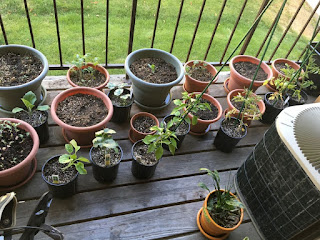 |
| Attempting to grow a variety of vegetables |
Saturday, February 29, 2020
Options For Where You Can Get Your Food From
Saturday, February 22, 2020
Why Grow Vegetables?
Saturday, February 15, 2020
Who Am I Anyways?
My name is James, I'm 32 years old, I'm from Colorado, I live in Longmont, Colorado and I'm a plant-a-holic (or veggienaut?). I have absolutely zero formal agriculture experience nor did I grow up in an environment where we grew a lot of plants. Before I owned a house I lived in various apartments for quite a while, I would occasionally get house plants or try and grow plants / vegetables on the porch. Any plant I touched would promptly die fairly fast, even the so-called "impossible to kill" houseplants would perish time and time again despite my best efforts to keep them alive.
 |
| Kelvin Floodlight Dinner Plate Dahlia |


